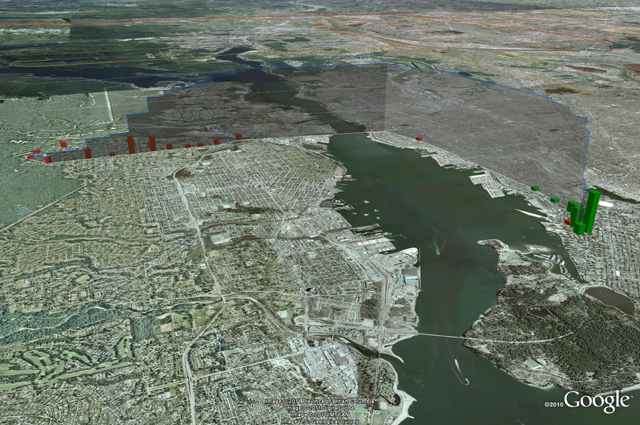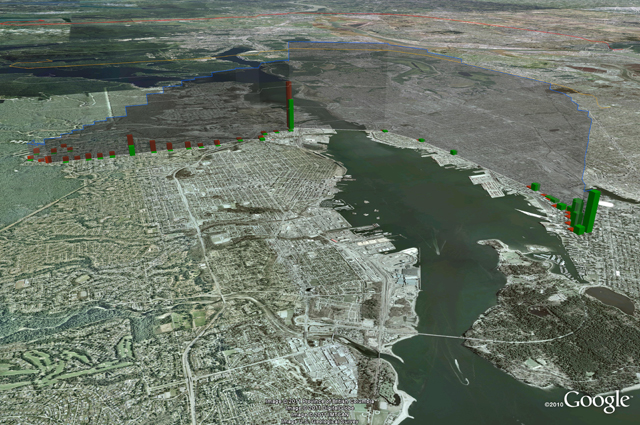June 2011 bus changes and the service optimization: an interview with TransLink planning director Brian Mills
June 2011 bus changes and the service optimization: an interview with TransLink planning director Brian Mills
If you’ve read the June issue of the Buzzer, you’d know that there are service changes beginning on Monday, June 20th. As part of a year-long TransLink service optimization project, aimed at making sure we’re using our transit resources efficiently and efficiently.

There’s a lot of small adjustments to a number of routes. The overall amount of service hours won’t change, and many more customers will see service increases than service reductions. The area of focus this time around is mostly West Vancouver and the North Shoare, but there are areas in Vancouver, Burnaby, New Westminster, Richmond, Delta, and elsewhere being affected. For the complete picture on the changes you’ll want to look at the Summer 2011 service changes page.
Some notable changes include:
- Granville Mall summer bus detours will be in effect June 24 – September 5 on Friday’s after 9pm, all day Saturdays/Sundays/holidays, and all day Friday July 15 and Friday August 19 for Viva Vancouver events
- The 19 will feature additional “short-turn” trips between Downtown Vancouver (Cambie at Pender) and Stanley Park for the summer months
- All 246 trips will travel to/from Vancouver throughout the day, seven days a week. Service to Park Royal discontinued. Customers travelling to Park Royal will need to transfer to the 239 or 255 on Marine Drive near Garden Road.
- To provide better connections between Downtown Vancouver and Phibbs Exchange during the p.m peak period, existing trips on the 290 and 292 will be converted to operate as 210 and 211 service. The upgraded 210 and 211 will offer consistent combined service leaving from downtown Vancouver to Phibbs Exchange every 7-8 minutes in the weekday p.m. peak. There will be no change to boarding locations as the 210 and 211 use the same stops as existing 292 and 290 services.
- Due to King Edward overpass construction, the 177 and 791 will detour via Lougheed Highway instead of travelling along the section of United Blvd. located south of Highway #1. Both routes will continue to serve Planet Ice and a temporary 197 Planet Ice/Brigantine Shuttle will provide transit service along the United Blvd. corridor, with the western terminus on Brigantine Dr. at Hartley. A new stop for the 791 will be located on United Blvd. southbound at Golden.
Brian Mills, TransLink’s Director of Service and Infrastructure Planning did an interview with the Buzzer last April about the service optimization. I thought it would be good to sit down with Brian again to give us some perspective on what’s different this time around, and just how TransLink decides which services need to be changed and why. Read on!
What’s your involvement with the June service optimization schedule changes?
As the Director for Service and Infrastructure Planning, my department is responsible for transport network design. Service optimization is an initiative where we look at the best use of our resources. This means we look at the system for services that are crowded and need some relief as well as areas where the service is less productive and not the best use of resources. We identify both of these situations and reallocate our resources to where people need and use the service. We also have a target of improving revenue productivity by two percent.
Do you find in this age of ever-tightening budgets that you have to look for more ways to save money?
Yes, TransLink is committed to being as efficient as possible. We’ve made the commitment to the region to use the resources that they’ve entrusted to us as efficiently as possible. Whether we’re in a constrained economic environment or not, it’s good business practice to always be reviewing services and reviewing targets. We set guidelines to help us assess service, so we’re always monitoring service to check how well they’re doing compared with the guidelines.
So why are some bus routes being affected and some aren’t this time around?
We looked at the profile of travel on each of these routes, and we found that some services need more service. Let me give you an example: We often hear from people that they want better service on the North Shore. There are a lot of people who use Phibbs Exchange on the North Shore to transfer buses, especially during rush hours. We had some routes from Vancouver, that served the exchange and others that bypassed it. The ones that go past generally have some capacity available, but those seats weren’t available for people making trips within the North Shore. Because the routes were separate, the trips weren’t scheduled to be spaced evenly apart. What we’ve done is to combine the routes so all the buses now go to Phibbs Exchange. They all make connections possible to and from other parts of the North Shore. And now anyone going between North Vancouver and Downtown can use any of these routes, and the combined service is more frequent overall. So even for someone who prefers to commute on the trips that bypass Phibbs Exchange, the new arrangement may be faster overall by reducing the wait downtown.
How do you actually know which routes are being underutilized and which routes need more capacity?
We have data that we collect on the buses. We have automatic passenger counters on 15% of the buses. There is an infrared beam that can tell how many people are on a bus, and how many people get on and off at each stop. One way we analyse service is to construct a profile of a route using our data overlaid on Google Earth (see diagram). We can then compare routes and tell which ones are performing better, if there is a redundancy in service, and so on. This is just one example of the types of analysis we do.


It seems to be that there are fewer changes this time around compared to April.
Yes, there are fewer changes.
How are these changes different from the ones we saw in April?
In many ways they are the same types of changes. We’ve been evaluating services in the whole region. In April, most of the service changes were in Burnaby, New Westminster, and Coquitlam with some changes in Surrey and Richmond. This time, the changes are mostly on the North Shore with some changes in Vancouver and Richmond. They are the same types of changes as in April: refinements in services, minor adjustments that relieve crowding in certain areas, some revisions to routes to provide more even service to customers and a couple of places where service will run less often because the service was not well used.
In one example (route 246) we are going to increase direct service on the more heavily used portion, simplifying the route at the same time. So this means the route will operate to and from downtown Vancouver all day. Customers travelling on the North Shore will still be well served with frequent service connecting to and from Park Royal. We make seasonal changes as well to provide more service where people ride in the summer months. For example, the City of Vancouver will be running summer programs downtown that will affect Granville Street, resulting in weekend detours. There is also an increase in weekend service to destinations like Stanley Park to reflect summer ridership patterns. The June changes will also serve White Pine Beach in Port Moody.
Is there a reason why these changes are happening in June and not another time in the year?
Communities and needs change over time. We always have service changes four times a year. That’s because travel patterns chance significantly when school starts in September, at the end of university terms in April, at the summer break, and we make one change around the new year to further refine services.
This is something we will always be doing to make sure the changes are doing what they were intended to do, that we are providing the best value to the community and that resources are available where they are most needed.
Some services are being shortened. Are there other options for people who used a bus at a certain time and can no longer do so?
Our guiding principles for service optimization lead us to seek opportunities where we can improve productivity while at the same time maintaining basic service for transit dependent customers and minimizing service reductions in areas where there are no other transit alternatives. So we’ve been careful to introduce changes where other trips or other routes provide similar service and where transfers are possible.
What’s the most difficult part of making service changes like these?
There are two parts of it. One is prioritizing where we invest. Identifying the areas with the highest need and the highest opportunity to improve revenue productivity of the service? And the second, is identifying the areas where we can reduce inefficiencies with the least impact to customers.
Thanks Brian. That was very informative!
Once again, if you want to know about ALL of new schedule changes you’ll want to go here!






I find it odd that the 197 wouldn’t connect with Braid via the single lane bridge as its western terminus, would make things a lot more convenient.
Hi Donald:
Hi Donald: I forwarded your comment to the planning departments at both TransLink and CMBC. Here’s what they had to say:
The changes to the 177 and 791, which include the temporary introduction of the 197 service, are a temporary adjustment made to accommodate construction on King Edward Street. CMBC considered using Braid Street, including the Bailey Bridge and the set of five railway tracks, for a detour routing during the full closure of King Edward Street. In the end, we decided that our
concerns with safety and service reliability outweighed the advantages.
I have been a happy traveler on the 246 Highland for over 7 years until the recent changes. I have to say that I am incredibly UNHAPPY with the new changes you have done to this bus. Not only has the stop moved with NO shelter and NO benches, but it now only runs to Vancouver which makes this bus incredibly unreliable especially during weekend rushes. Me and 6 other people were stuck at the new 61510 stop waiting for 30 minutes in the hot sun here: http://img.photobucket.com/albums/v60/NomadSoul/Translink/bus.jpg . It left me angry beyond belief and sunburnt.
The decision to decrease frequency after 7pm was a major mistake. Now, we all get stranded for 60 minutes if we miss the link up now that it no longer runs to Park Royal. Some of us riders feel completely SCREWED by these changes and are enraged by it. Now it is incredibly difficult and stressful for me to come home from work in the evening now that the bus only runs every hour. I can’t begin to tell you the SHITTY experiences I have had recently and the photograph is just one. I DO NOT SUPPORT THESE CHANGES AND I AM FURIOUS THAT THEY WERE SO DRASTIC.
I am a tax-paying, fare-buying, full-time working resident and student with Capilano University. Since there is only the ONE BUS going up the hill, Translink could have been a little more generous with its changes instead of SCREWING THE LOT OF US. My question is: WHAT ARE YOU GOING TO DO TO HELP YOUR FELLOW FARE-PAYING RIDERS OF THE 246???
Hi Jaime,
I’ve received some feedback on your post form our planning department. Sorry for the delay. A quick note about shelters…they are a municipal matter which are not controlled by TransLink. Although TransLink can recommend adding new shelters, it’s ultimately up to your local government to install them. Thanks for the comment Jamie!
Service Issue – The June 2011 service changes featured a number of changes to the “246 Vancouver/Lonsdale Quay via Highland”. Observed ridership patterns on the 246 indicated significantly more demand for service operating to/from Downtown Vancouver. At all other times (when trips operate to and from Park Royal) passenger loads are very low (approximately 3-4 people per trip) and service is duplicated by routes 239 and 255. Also, customer demand for service in the evening is low – in the bottom 25% of productivity in comparison to other routes in the system.
Change Details – Given the observed ridership patterns on the 246, in June 2011 all trips were extended to operate directly to and from Downtown Vancouver. In addition, service levels were adjusted after 7 p.m. to once an hour from once every half-hour. Hours of operation were also extended with a new late-night northbound trip to coincide with the last northbound SeaBus sailing.
Service Intent – The intent of these service changes was to offer direct service all day from Highland/Edgemont Village to Downtown Vancouver over the Lions Gate Bridge, supporting the desired travel patterns for people in the Highland/Edgemont neighbourhoods. As well, the reduction of evening service allows TransLink to make improvements in other parts of the North Shore, in particular to bring the 239 to FTN levels of service. Extending late-night bus service allows for a better connection with the last northbound SeaBus.
Customer Impacts and Mitigation – The additional transfer between the 246 and 239 has raised some concerns among local area residents. TransLink has been in contact with municipal staff to investigate opportunities for long-term mitigation which may involve improvements to bus stop accessibility, enhancements to customer amenities at key stops and improved weather protection at transfer points. The improvement of the 239 to Frequent Transit levels of service also helps to mitigate the transfer issue by reducing passenger wait times between services.
[…] Most of the Buzzer is devoted to the bus service changes happening on June 25, 2012—all of the changes are online here. There are regular seasonal changes, as well as changes coming as part of the service optimization project that we talked about in 2010. (See a couple of interviews on this topic from April, and June 2011.) […]
I’m glad Translink is not a person because it was, it would have jumped off a bridge by now. Every time it makes management decisions to serve more people better, a mass of people gets mad at it, and the bigger group of people that benefits does not thank it.
Translink staff, thanks for being great ambassadors being respectful and rational even when facing the angriest most vulgar people.